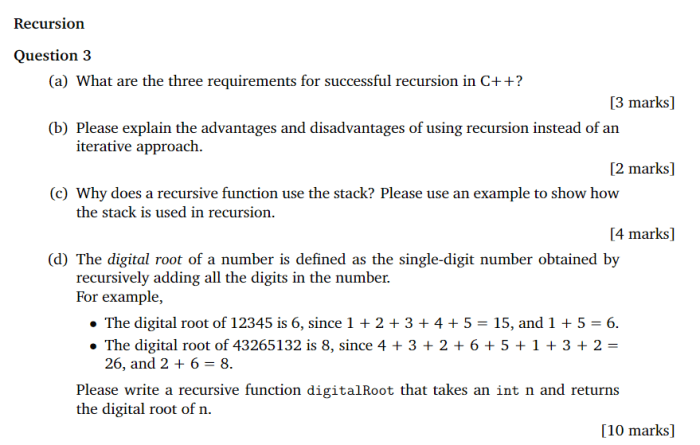Answer the questions with words recursion or mutual recursion. This concept, prevalent in programming and beyond, opens up a world of possibilities for solving complex problems. Recursion, where a function calls itself, and mutual recursion, where two or more functions call each other, offer unique approaches to tackling intricate challenges.
In this exploration, we delve into the intricacies of recursion, examining its applications in programming, data structures, algorithms, mathematics, natural language processing, and more. Along the way, we uncover the benefits and drawbacks of this powerful technique, gaining insights into its strengths and limitations.
Recursion: Answer The Questions With Words Recursion Or Mutual Recursion.

Recursion is a programming technique that allows a function to call itself. This can be useful for solving problems that have a recursive structure, such as finding the factorial of a number or traversing a tree.
Recursion works by creating a stack frame for each recursive call. Each stack frame contains the local variables and the return address for the function. When the function returns, the stack frame is popped and the execution continues from the return address.
Recursive Functions, Answer the questions with words recursion or mutual recursion.
Here is an example of a recursive function that calculates the factorial of a number: int factorial(int n) if (n == 0) return 1; else return n
- factorial(n
- 1);
This function works by calling itself with a smaller value of n until n reaches 0. At that point, the function returns 1. The previous recursive calls then return the product of n and the result of the recursive call with n1.
This process continues until the original value of n is reached, at which point the function returns the factorial of n.
Mutual Recursion
Mutual recursion is a type of recursion in which two or more functions call each other. This can be useful for solving problems that have a mutually recursive structure, such as finding the greatest common divisor of two numbers or solving a system of linear equations.Here
is an example of two mutually recursive functions that find the greatest common divisor of two numbers: int gcd(int a, int b) if (b == 0) return a; else return gcd(b, a % b); These functions work by calling each other with smaller values of a and b until b reaches 0. At that point, the first function returns a, which is the greatest common divisor of a and b.
The second function returns the greatest common divisor of b and a % b, which is the same as the greatest common divisor of a and b. This process continues until the original values of a and b are reached, at which point the functions return the greatest common divisor of a and b.
FAQ Insights
What is the key difference between recursion and mutual recursion?
Recursion involves a function calling itself, while mutual recursion involves two or more functions calling each other.
What are the advantages of using recursion?
Recursion can simplify code, enhance readability, and provide an elegant solution to complex problems.
What are the limitations of recursion?
Recursion can lead to stack overflows and may not be suitable for all problem types.

